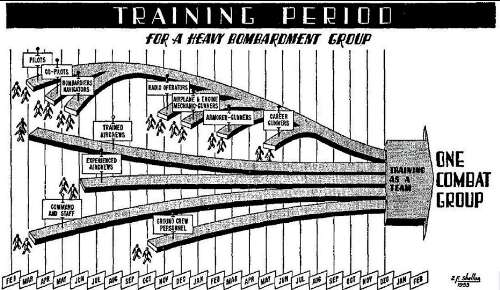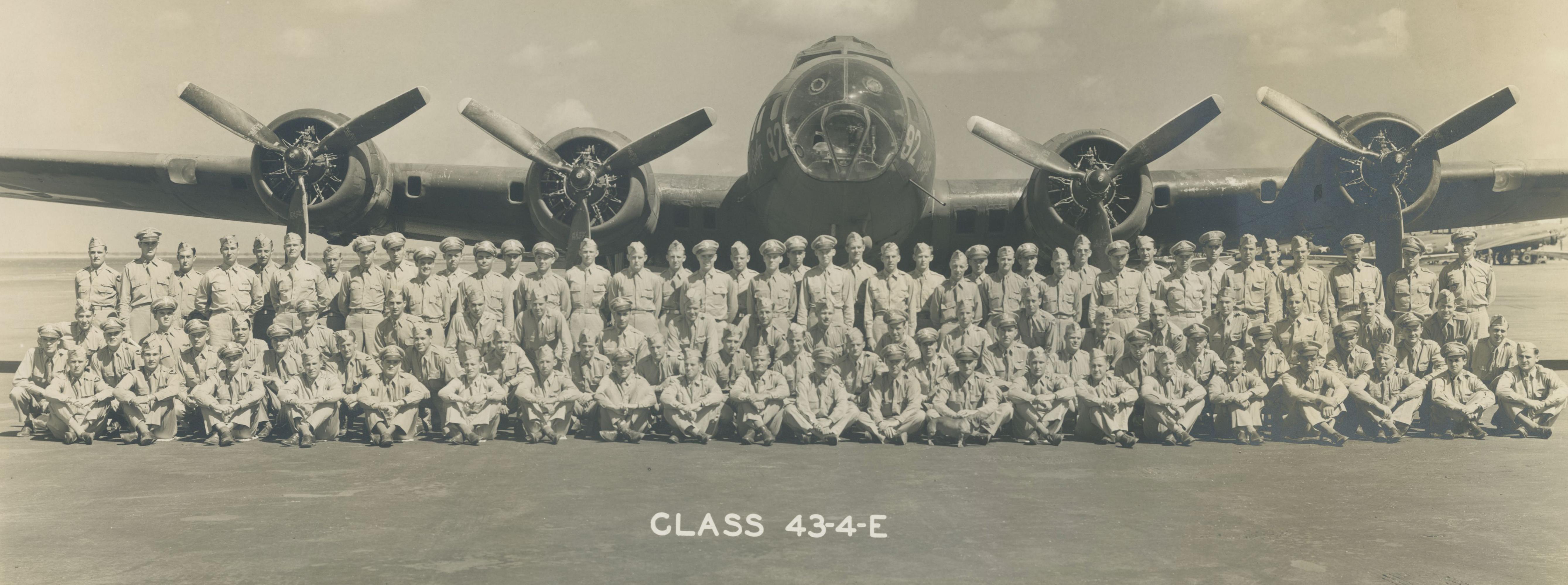Bomb Group Training
The attached chart shows what the Air Force thought were times needed to properly prepare an air crew for combat. These schedules were shortened as the war went on to get more crews involved in the battle.
Bombardment Training Programs
Since the heavy bomber was the backbone of the American air offensive, the training of crews and units to man the big planes became the primary task of the system. The statistical record for the first year of the war is not available, but approximately 27,000 heavy bombardment crews were trained in the period from December 1942 to August 1945; slightly more than half of that number flew B-24s, the other, B-17s. During the same period, about 6,000 crews were trained for medium bombardment and only 1,600 for light bombardment. The B-29 program, which did not get under way until the fall of 1943, turned out approximately 2,350 crews.
The Second Air Force, which conducted the major portion of heavy bombardment training, divided it into three principal phases. Until the end of 1943 each of the phases was usually given at a different base, but that arrangement was then abandoned in favor of giving the entire program at one station. During the first phase, individual crew members received instruction in their specialties, particular attention being given to instrument and night flying exercises for pilots, cross-country tests for navigators, target runs for bombardiers, and air-to-air firing for gunners. During the second phase, teamwork of the combat crew was stressed: bombing, gunnery, and instrument flight missions were performed by all crews. The third phase aimed at developing effective unit operation, the goal of the entire program. It included extensive exercises in high-altitude formation flying, long-range navigation, target identification, and simulated combat missions.
The requirements of bombardment crew instruction were laid down in published training standards. Throughout the war the standards were continually modified in accordance with technical developments and combat experience, but the successive issues followed a definite pattern. Each standard made a general statement of the purpose of the particular instructional program referred to. The ideal of unit training, as specified in these directives, was to create “a close knit, well organized team of highly trained specialists of both the air and ground echelon.” Detailed statements, serving as measurements for achievement of the goal, composed the largest portion of a directive; these details related to administrative and technical as well as tactical matters. Bombardment units were required, for example, to demonstrate ability to service and repair their aircraft under field conditions, to provide defense against chemical attack, and to carry out proper intelligence procedures.
These training standards established requirements to be met at all levels of performance. Detailed lists prescribed the particular duties which each man had to be able to carry out, and if the individual was deficient in any respect, additional instruction had to be given. Crew members were to understand their responsibilities not only for their particular jobs but also to each other; they were to complete successful tests in sustained high-altitude flights, evasion exercises, and precision bombing runs. Units had to demonstrate their ability to take off, assemble, and land together; to operate in the air under radio silence and through overcast; to fly all types of formations; and to execute simulated bombardment missions.
When the individual pilot, gunner, or other flying specialist arrived at his new station, the main concern was the character of his crew. The crew was the family circle of an air force; each member knew that long hours of work, play, anxiety, and danger would be shared. Naturally, each man hoped to be assigned to a crew in whose members he had confidence and with whom he would be congenial. The assignment process was almost entirely a matter of checking names from alphabetical rosters, but the men so assigned generally accepted each other and adjusted gradually to the mixture of backgrounds and temperaments. If trouble flared, reassignment of individuals could always be made. To each member of the crew a vital part of the operational training period was learning about the personalities, as well as the duties, of his crew mates. Much instruction was given on the ground – in classrooms, hangars, and on gunnery ranges. Air training was conducted chiefly through informal supervision of flight operations.
![]()
Training was done in Classes with each class having a designation. Currently I only have one class to post here and I have no idea where these men ended up. I assume at least some of them may have served in the Fifteenth Air Force, but it would take a long time to track them down. By posting the class photo along with the names of the men, I hope it helps family member to located the men.
Class 43-4-E
HAAF, Hobbs, N. MEX.
First Row (L-R): Hess, W.D.; Whipple, E.F.; Gelling, R.G.; Farris, C.L.; Duke, E.L.; Decker, R.B.; McKay, W.T.; Manning, D.E.; Neary, M.R.; Watson, R.H.; Gould, G.; Ricks, L.S.; David, R.G., Foster, R.R., Dooko, B.M.; Darrow, R.N.; Diebold, J.J.; Allen, F.B.; Broxton, H.E.; Bradford, M.A.; Thomaides, A.
Second Row (L-R): Goetz, W.B.; Carter, W.R.; Allender, W.M.; Hickey, C.L.; Ingram, R.M.; DeNeffe; F.M.; Patrick, W.H.; Nivens, W.B.; Meek, H.J.; Dean, S.G.; Brown, C.E.; Sikkenga, A.L. Chase, P.J.; Byrne, A.D.; Tooman, W.F.; Brent, D.A.; Britton, C.M.; Knorr, C.; Knight, J.W.; Kloeppel, P.E.; Tigh, W.P.
Third Row (L-R): Clark, C.M.; Dunlap, E.V.; Campbell, F.; Mcbride, W.; Davis, C.R.; Cromwell, E.V.R.; Feeney, J.R., Voskian, A.A.; Cox, P.K.; Russell, M.B.; Andrus, B.E.; Coyle, J.J.; Brown, C.L.; Brashear, J.R.; Anderson, T.L.; Kleinberger, W.H. Cleland, J.R.; Miller, F.C.; Overdorf, H.W.; Hawkins, E.L.
Fourth Row (L-R): Tobin, P.D.; Nance, E.T.; McKay, E.N.; Condra, P.T.; Neuberg, R.E.; Kreuzer, H.L.; Dietrich, J.H.; Dunham, M.B.; McMannus, K.L.; Milton, L.A.; King, W.K.; Nelson, G.R.; Lindahl, R.L.; Howsam, E.R; Murdock, W.E., Price, J.G.; McAdams, R.L.; Campbell, R.J.: Keahey, G.O.; Brandfass, D.C.; Riedman, J.E.; Alspaugh, M.L.
Fifth Row (L-R): Rhodes, J.P.; Northrup, A.L.; Neuman, D.J.; Pries, E.H.; Swayze, J.; Ross, W.O.; Rhodes, J.F.; Granack, F.A.; Lee, O.I.; Marcy, C.H.; McAllister, W.L.; Sharp, J.C.; Malvik, A.A.; McAllister, W.B.; Zurynetz, W.; Birchett, J.W., Prewitt, T.G.; Graybeal, J.M.; Maroney, G.J.


